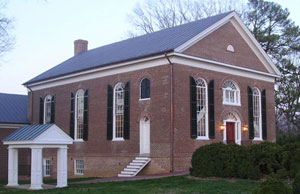
Rappahannock Christian Church
a Disciples of Christ congregation in Dunnsville, Virginia
Church Undergoes RestorationThanks to the beneficence of Elizabeth and Ludwell Smither and Wilson C. Ware, the Rappahannock Christian Church (Disciples of Christ) building, at Dunnsville, is undergoing a complete restoration. In their wills, Mr. and Mrs. Smither and Ware provided funds to restore the building to its original state. Rappahannock Church was founded in 1832. In 1834 the congregation built a wooden building near the present building which was known as Rappahannock Meeting House. Both Thomas Campbell and Alexander Campbell, his son, Presbyterian ministers who had emigrated from Northern Ireland to America, preached extensively in Tidewater Virginia in 1830 and 1831. Alexander was a member of the Virginia Constitutional Convention of 1830. The Campbells, along with Barton W. Stone, another Presbyterian minister, founders of the denomination, were prominent leaders of the Restoration Movement which helped fill the religious void in America caused by the disestablishment of the Church of England. Over time, the Christian Church (Disciples of Christ) has become one of many main-line denominations; however, the Campbells preached that the Church should be one, and that its teachings should be those of Christ and the Apostles, not based on creeds or theology. Records reveal that Alexander Campbell came to Essex County, staying at Bellevue, the home of Edmund Macon Ware, and preached at Rappahannock Meeting House. The congregation grew rapidly. By 1858 the wooden building could no longer accommodate the members. That year local people subscribed to the drive organized to provide funds to erect the present church building. Many names of families still connected with Rappahannock and Essex County can be found on the list of subscribers—Ainslie, Cauthorn, Cox, Derieux, Dillard, Henley, Hundley, Garnett, Trible, Ware, Waring, and others. Washington L. Clarke, architect and joiner, and Dr. Leonard Henley, builder, were commissioned to construct the present building where services were first held on the fourth Sunday in May, 1861. The building is of Roman design, reflecting a Colonial influence in the interior. It is testimony to the prosperity of mid-19th century Tidewater Virginia. Due to the desolation which affected Essex County after the War Between the States, the construction debt was not satisfied until the early 20th century. The work now underway includes removing many layers of exterior paint, repairing and restoring the original mouldings and shutters, painting, removal of Portland cement used in the past years to repair mortar joints, and re-pointing with lime of the kind used in the 1800s and sand mined on the site. New London Brick Company is providing brick to be used as needed. The front steps will be reconstructed to represent the original steps. The interior plaster will be repaired and painted. Additionally, an interior elevator will be installed at the rear of the building. This will allow handicapped persons complete access to all parts of the building. The building committee strives to use as many local artisans as possible. Some of the individuals offering their talents to the project are J.D. Davis, Jr., Michael Parker, Eddie Boudreaux, J.L. Clark, and James Ryland. Those offering technical advice and support for the project are John Greenwalt Lee and Ellen Hagstan of Annapolis and Charles Phillips, AIA, of Winston-Salem. They have worked at Menokin, the home of Francis Lightfoot Lee, for several years and represent the very best talent available in the restoration field. The studies, drawings, and specifications for the project have been provided by J. Murray Howard, AIA, formerly the architect in charge of the historic buildings at the University of Virginia, and Roland McPherson, P.E., of Portsmouth, who surveyed the building and continues to provide assistance. The congregation plans to formally celebrate its 175th anniversary upon completion of the project. By Alexander F. Dillard, Jr. |